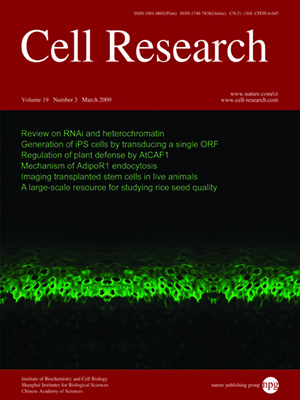
Volume 19, No 3, Mar 2009
ISSN: 1001-0602
EISSN: 1748-7838 2018
impact factor 17.848*
(Clarivate Analytics, 2019)
Volume 19 Issue 3, March 2009: 370-379
ORIGINAL ARTICLES
Serial imaging of human embryonic stem-cell engraftment and teratoma formation in live mouse models2
Martin G Pomper1, Holly Hammond2,3, Xiaobing Yu2,3, Zhaohui Ye2,3,4, Catherine A Foss1, Doris D Lin1, James J Fox1 and Linzhao Cheng2,3,4
1Department of Radiology and Radiological Sciences, Johns Hopkins School of Medicine, Baltimore, MD 21231, USA;
2Stem Cell Program, Institute for Cell Engineering, Johns Hopkins School of Medicine, Baltimore, MD 21205, USA;
3Department of Gynecology & Obstetrics, Johns Hopkins School of Medicine, Baltimore, MD 21205, USA;
4Graduate Program in Immunology, Johns Hopkins School of Medicine, Baltimore, MD 21205, USA
Correspondence: Linzhao Cheng, Martin G Pomper,(lcheng@welch.jhu.edu; mpomper@jhmi.edu )
Two new types of lentiviral vectors expressing a reporter transgene encoding either firefly luciferase (fLuc) for bioluminescence imaging or the HSV1 thymidine kinase (HSV1-TK) for radiopharmaceutical-based imaging were constructed to monitor human embryonic stem cell (hESC) engraftment and proliferation in live mice after transplantation. The constitutive expression of either transgene did not alter the properties of hESCs in the culture. We next monitored the formation of teratomas in SCID mice to test (1) whether the gene-modified hESCs maintain their developmental pluripotency, and (2) whether sustained reporter gene expression allows noninvasive, whole-body imaging of hESC derivatives in a live mouse model. We observed teratoma formation from both types of gene-modified cells as well as wild-type hESCs 2-4 months after inoculation. Using an optical imaging system, bioluminescence from the fLuc-transduced hESCs was easily detected in mice bearing teratomas long before palpable tumors could be detected. To develop a noninvasive imaging method more readily translatable to the clinic, we also utilized HSV1-TK and its specific substrate, 1-(2'-deoxy-2'-fluoro-β-D-arabinofuranosyl)-5-[
125I]iodouracil ([
125I]FIAU), as a reporter/probe pair. After systemic administration, [
125I]FIAU is phosphorylated only by the transgene-encoded HSV1-TK enzyme and retained within transduced (and transplanted) cells, allowing sensitive and quantitative imaging by single-photon emission computed tomography. Noninvasive imaging methods such as these may enable us to monitor the presence and distribution of transplanted human stem cells repetitively within live recipients over a long term through the expression of a reporter gene.
Cell Research (2009) 19:370-379. doi: 10.1038/cr.2008.329; published online 30 December 2008
FULL TEXT | PDF
Browse 1999


